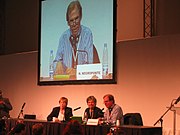The XO-1, previously known as the $100 Laptop or Children's Machine, is an
inexpensive laptop computer intended to be distributed to children around the
world, especially to those in developing countries, to provide them with access
to knowledge. The laptop is developed by the One Laptop per Child (OLPC) social
welfare organization. OLPC is a U.S. based, non-profit organization, 501(c)(4)
created by faculty members of the MIT Media Lab to design, manufacture, and
distribute the laptop and its software.
These rugged, low-power computers contain flash memory instead of a hard drive
and use Linux as their operating system.[1] Mobile ad-hoc networking is used to
allow many machines Internet access from one connection.
The laptops can be sold to governments and issued to children by schools on a
basis of one laptop per child. Pricing is currently set to start at US$188 and
the goal is to reach the US$100 mark in 2008. Approximately 500 developer boards
(Alpha-1) were distributed in summer 2006; 875 working prototypes (Beta 1) were
delivered in late 2006; 2400 Beta-2 machines were distributed at the end of
February 2007; full-scale production is expected to start in mid-2007.[2] Quanta
Computer, the project's contract manufacturer, said in February 2007 that it had
confirmed orders for one million units. They indicated they could ship 5 million
to 10 million units this year because seven nations have committed to buy the
XO-1 for their schoolchildren, including Argentina, Brazil, Libya, Nigeria,
Rwanda, Thailand and Uruguay.[3]
The OLPC project has stated that a consumer version of the XO laptop is not
planned.[4] However, Quanta will be offering machines very similar to the XO
machine on the open market.[5] Emerging competitors in the category include the
ASUS Eee PC.
One Laptop per Child associationThe One Laptop per Child
association (OLPC) is a Delaware, USA based, non-profit organization set up to
oversee The Children's Machine project and the construction of the XO-1 "$100
laptop". Both the project and the organization were announced at the World
Economic Forum in Davos, Switzerland in January 2005.
OLPC is funded by a number of sponsor organizations, including AMD, Brightstar
Corporation, eBay, Google, Marvell, News Corporation, SES, Nortel Networks, Red
Hat, and most recently Intel[6]. Each company has donated two million
dollars.[7]
The organization is chaired by Nicholas Negroponte and its CTO is Mary Lou
Jepsen. Other principals of the company include former MIT Media Lab director
Walter Bender, who is President of OLPC Software and Content, and Jim Gettys,
Vice-President of Software Engineering
History
OLPC is based on constructionist learning theories pioneered by Seymour
Papert, Alan Kay, and also on the principles expressed in Nicholas Negroponte’s
book Being Digital.[9] The founding corporate members are Google, News Corp,
AMD, Red Hat, Brightstar and Nortel, each of whom donated two million dollars to
the project. All three individuals and six companies are active participants in
OLPC.
The organization gained much attention when Nicholas Negroponte and Kofi Annan
unveiled a working prototype of the CM1 on November 16, 2005 at the World Summit
on the Information Society (WSIS) in Tunis, Tunisia. Negroponte showed two
prototypes of the laptop at the second phase of the World Summit: a non working
physical model and a tethered version using an external board and separate
keyboard. The device shown was a rough prototype using a standard development
board. Negroponte estimated that the screen alone required three more months of
development. The first working prototype was demonstrated at the project's
Country Task Force Meeting on May 23, 2006. The production version is expected
to have a larger display screen in the same size package. The laptops were
scheduled to be available by early 2007.
Production prototype (4th generation) - functional surveyAt the 2006 World
Economic Forum in Davos, Switzerland, the United Nations Development Program (UNDP)
announced it would back the laptop. UNDP released a statement saying they would
work with OLPC to deliver “technology and resources to targeted schools in the
least developed countries”.[10]
The OLPC board of directors announced on December 13, 2005 that Quanta Computers
had been chosen as the original design manufacturer (ODM) for the $100 laptop
project. The decision was made after the board reviewed bids from several
possible manufacturing companies. The company emphasized that there was a lot of
work that remains to be done: “We still need to put a large amount of research
and development into this, and will then hopefully be ready to make a finished
product in the second half of next year 2006”, according to Quanta. Over the
next six months, a team at Quanta Research Institute is going to be focusing on
the $100 laptop.[11]
The project originally aimed for a price of 100 United States dollars. In May
2006, Negroponte told the Red Hat's annual user summit: “It is a floating price.
We are a nonprofit organization. We have a target of $100 by 2008, but probably
it will be $135, maybe $140. That is a start price, but what we have to do is
with every release make it cheaper and cheaper— we are promising that the price
will go down











 My StumbleUpon Page
My StumbleUpon Page.gif)

























No comments:
Post a Comment